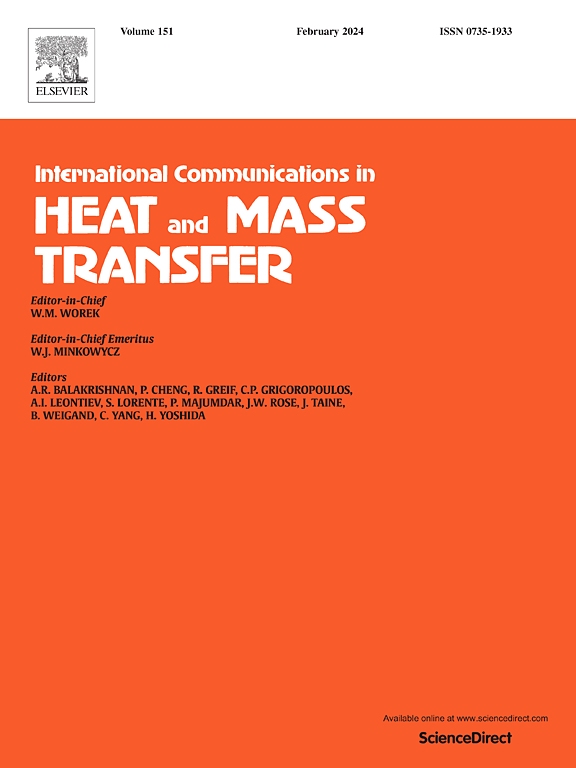Experimental investigation of twisted tape-induced mixed convection for optimized thermofluidic performance in transitional flow regimes
IF 6.4
2区 工程技术
Q1 MECHANICS
International Communications in Heat and Mass Transfer
Pub Date : 2025-03-21
DOI:10.1016/j.icheatmasstransfer.2025.108865
引用次数: 0
Abstract
The current study aims to experimentally investigate the thermohydrodynamics coaction in a solar air heater tube equipped with twisted tape turbulators, specifically focusing on laminar and transitional flow regimes. This study uses air with Reynolds numbers (Rea) from 563 to 10,240. Wall heat flux (q) is uniform on heat exchanger tube. On the tube surface, “2, 3, and 4” kW-m−2 heat fluxes are used. Twisted tapes with twist ratios (y) “3, 4 and 5” were used as passive heat transfer enhancement devices. The results of heat transfer are presented in terms of Nusselt number (Nua) and Colburn j-factor (j) while the pressure drop is presented as friction factor (f). The results revealed changes in the transition boundary. For plain channel being subjected to uniform heat flux of 3 kW-m−2, the transition begins at Rea equals to 2595 and ends at Rea 3833. For twisted tape having twist ratio 3 at 4 kW-m−2 heat flux, the improvement in the heat transfer was highest. Similar results were obtained for f. Four empirical correlations were developed for predicting the Nusselt number (Nua) and friction factor (f), achieving deviations as low as ±0.75 % from experimental data. These correlations provide highly reliable guidance for optimizing heat exchanger design and performance.
Novelty
This study explores the underexamined transitional flow regime in a solar air heater tube using twisted tape inserts, providing crucial insights into heat transfer and pressure drop. Unlike most works focusing on liquids, it uses air as the working fluid, relevant for solar and HVAC applications. The research identifies critical Reynolds numbers, achieving optimal heat transfer enhancement at a twist ratio of 3 and a heat flux of 4 kW/m2. Novel empirical correlations for Nusselt number and friction factor are developed to guide heat exchanger design. The study also evaluates the economic viability of these enhancements, bridging a key knowledge gap in thermal optimization.
求助全文
约1分钟内获得全文
求助全文
来源期刊
CiteScore
11.00
自引率
10.00%
发文量
648
审稿时长
32 days
期刊介绍:
International Communications in Heat and Mass Transfer serves as a world forum for the rapid dissemination of new ideas, new measurement techniques, preliminary findings of ongoing investigations, discussions, and criticisms in the field of heat and mass transfer. Two types of manuscript will be considered for publication: communications (short reports of new work or discussions of work which has already been published) and summaries (abstracts of reports, theses or manuscripts which are too long for publication in full). Together with its companion publication, International Journal of Heat and Mass Transfer, with which it shares the same Board of Editors, this journal is read by research workers and engineers throughout the world.

 求助内容:
求助内容: 应助结果提醒方式:
应助结果提醒方式:


